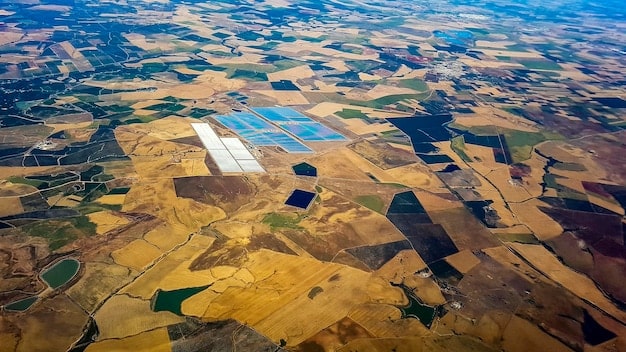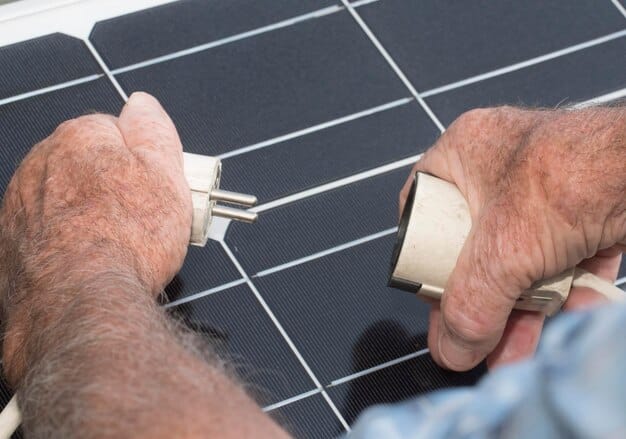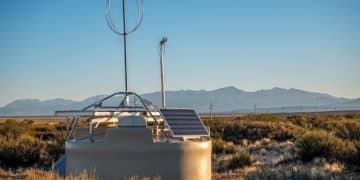US Renewable Energy Subsidies: Your Guide to Claiming Incentives in 2025

US government subsidies for renewable energy in 2025 provide financial incentives, including tax credits and grants, to businesses and individuals investing in solar, wind, and other green energy projects, aiming to drive clean energy adoption and reduce carbon emissions.
Are you looking to invest in renewable energy and claim your share of the available incentives? Understanding the landscape of US government subsidies for renewable energy in 2025 is crucial for maximizing your returns and contributing to a sustainable future. With various programs and initiatives available, navigating the application process can seem daunting, but with the right guidance, you can access these valuable resources.
Understanding Federal Renewable Energy Subsidies
Federal renewable energy subsidies play a pivotal role in accelerating the adoption of clean energy technologies across the United States. These subsidies help offset the initial costs of renewable energy projects, making them more economically viable for businesses, homeowners, and communities. By understanding the types of subsidies available, you can better plan your investments and take advantage of the financial support offered by the government.
Types of Federal Subsidies
Federal subsidies come in various forms, each designed to support different aspects of renewable energy development. These include tax credits, grants, loan programs, and production incentives. Knowing which ones apply to your specific project is key to securing funding and maximizing your benefits.
- Tax Credits: These reduce your income tax liability and are often based on a percentage of the project’s cost.
- Grants: Direct financial awards that do not need to be repaid, typically awarded to projects with significant public benefits.
- Loan Programs: Offer low-interest loans or loan guarantees to reduce the financial burden of renewable energy investments.
- Production Tax Credits (PTC): Provide incentives based on the amount of electricity generated from renewable sources.

Key Agencies Involved
Several federal agencies administer renewable energy subsidy programs. The Department of Energy (DOE), the Internal Revenue Service (IRS), and the Department of Agriculture (USDA) are among the key players. Each agency offers different programs and has specific eligibility requirements.
Navigating the federal subsidy landscape requires understanding the roles and responsibilities of each agency. The DOE focuses on research, development, and deployment of renewable energy technologies. The IRS administers tax credits and provides guidance on claiming them. The USDA supports renewable energy projects in rural areas through grants and loan programs.
In conclusion, federal renewable energy subsidies are a critical tool for driving the clean energy transition. By understanding the types of subsidies available and the agencies involved, you can identify the best opportunities for your renewable energy investments.
Navigating Tax Credits for Renewable Energy
Tax credits are a significant financial incentive for investing in renewable energy. They allow individuals and businesses to reduce their income tax liability based on a percentage of the cost of their renewable energy projects. Understanding how these credits work and how to claim them is essential for maximizing your return on investment.
Investment Tax Credit (ITC)
The Investment Tax Credit (ITC) is one of the most important federal tax credits for renewable energy. It applies to solar, wind, and other renewable energy technologies. The ITC provides a percentage-based credit on the cost of installing eligible renewable energy systems.
The value of the ITC has varied over time, but has generally been around 30% for solar projects. However, this rate is subject to change, so staying updated on current legislation is crucial. Claiming the ITC involves filling out the appropriate tax forms and providing documentation of the project’s cost and eligibility.
Production Tax Credit (PTC)
The Production Tax Credit (PTC) is another key incentive, particularly for wind energy. Unlike the ITC, which is based on the initial investment, the PTC provides a credit for each kilowatt-hour (kWh) of electricity generated from renewable sources.
- Eligibility: The PTC is primarily available for wind, biomass, and geothermal energy projects.
- Credit Value: The credit value is adjusted annually for inflation.
- Claiming: To claim the PTC, you must track your electricity production and file the appropriate tax forms.
Understanding the ITC and PTC is crucial for anyone investing in renewable energy. These tax credits can significantly reduce the cost of your project and improve its financial viability. Consult with a tax professional to ensure you are taking full advantage of these incentives.

Exploring Grant Programs for Renewable Energy
Grant programs offer direct financial assistance for renewable energy projects, without the requirement of repayment. These grants are typically awarded to projects that demonstrate significant public benefits, such as reducing carbon emissions, creating jobs, or promoting energy independence. Exploring these programs can provide a valuable source of funding for your renewable energy initiatives.
Department of Energy (DOE) Grants
The Department of Energy (DOE) offers a variety of grant programs aimed at supporting renewable energy research, development, and deployment. These grants often target innovative technologies and projects that have the potential to transform the energy landscape.
DOE grants can cover a wide range of renewable energy technologies, from solar and wind to geothermal and biomass. The application process is typically competitive and requires a detailed proposal outlining the project’s objectives, technical approach, and expected outcomes.
Department of Agriculture (USDA) Grants
The Department of Agriculture (USDA) provides grants and loan programs specifically for renewable energy projects in rural areas. These programs aim to promote economic development and energy independence in rural communities.
- REAP Grants: The Rural Energy for America Program (REAP) offers grants and loan guarantees to agricultural producers and rural small businesses for renewable energy systems and energy efficiency improvements.
- Eligibility: REAP grants are available for a wide range of renewable energy technologies, including solar, wind, biomass, and hydropower.
- Application: The application process involves submitting a detailed project proposal and meeting specific eligibility requirements.
Exploring grant programs is a vital step in securing funding for your renewable energy project. Both the DOE and USDA offer valuable resources to support renewable energy development across the United States. Carefully review the eligibility requirements and application guidelines for each program to maximize your chances of success.
Loan Programs and Financing Options
Loan programs and innovative financing options can significantly ease the financial burden of investing in renewable energy. These programs offer favorable terms, such as low-interest rates and extended repayment periods, making renewable energy projects more accessible to a wider range of individuals and businesses.
Small Business Administration (SBA) Loans
The Small Business Administration (SBA) offers loan programs that can be used to finance renewable energy projects for small businesses. These loans are often guaranteed by the SBA, reducing the risk for lenders and making it easier for small businesses to obtain financing.
SBA loans can be used for a variety of purposes, including the purchase of renewable energy equipment, installation costs, and energy efficiency improvements. The application process involves working with an SBA-approved lender and meeting specific eligibility requirements.
State and Local Loan Programs
In addition to federal programs, many states and local governments offer loan programs and financing incentives for renewable energy projects. These programs often target specific technologies or sectors and can provide valuable support for local renewable energy initiatives.
- State Energy Offices: Many state energy offices offer loan programs, rebates, and tax incentives for renewable energy projects.
- Local Initiatives: Some cities and counties offer financing options for residential and commercial renewable energy installations.
- Example: A city might offer low-interest loans for homeowners who install solar panels.
Exploring loan programs and financing options is an essential part of planning your renewable energy project. By leveraging these resources, you can reduce your upfront costs and improve the long-term financial viability of your investment. Be sure to research both federal and state programs to identify the best options for your specific needs.
Eligibility Criteria for Renewable Energy Subsidies
Understanding the eligibility criteria for renewable energy subsidies is crucial for successfully claiming your share of the available incentives. Each subsidy program has specific requirements that must be met to qualify for funding or tax credits. Carefully reviewing these criteria before starting your project can save you time and resources.
Project Size and Type
Many subsidy programs have requirements regarding the size and type of renewable energy project. Some programs target small-scale residential installations, while others focus on large-scale commercial or utility-scale projects.
For example, the Investment Tax Credit (ITC) is available for both residential and commercial solar projects, but the eligibility requirements may differ slightly. Similarly, some grant programs may prioritize specific renewable energy technologies, such as wind or geothermal.
Location Requirements
Some subsidy programs have geographic restrictions, targeting renewable energy projects in specific regions or communities. These restrictions may be based on factors such as energy needs, economic development goals, or environmental concerns.
- Rural Areas: The USDA’s REAP program, for example, is specifically designed for renewable energy projects in rural areas.
- State-Specific Programs: Many states offer their own subsidy programs with eligibility requirements that are specific to the state.
- Example: A state might offer enhanced incentives for projects located in economically distressed areas.
Performance Standards
Some subsidy programs require renewable energy projects to meet certain performance standards to qualify for incentives. These standards may relate to energy efficiency, electricity generation, or environmental impact.
For example, a grant program might require a solar installation to meet a minimum efficiency rating or a wind farm to demonstrate a certain level of electricity production. Meeting these performance standards ensures that the subsidy program is supporting projects that deliver real energy benefits.
Ensuring your project meets all eligibility criteria is an essential step in the subsidy application process. Carefully review the requirements for each program and gather the necessary documentation to support your application.
Step-by-Step Guide to Claiming Subsidies in 2025
Claiming your share of US government subsidies for renewable energy in 2025 involves a systematic approach. This step-by-step guide outlines the key actions to take to navigate the application process successfully.
Research Available Programs
The first step is to thoroughly research the available federal, state, and local subsidy programs. Identify the programs that align with your project’s size, type, and location. Use online resources, government websites, and industry associations to gather information.
Create a spreadsheet or database to track the key details of each program, including eligibility requirements, application deadlines, funding amounts, and contact information. This organized approach will help you stay on top of the application process.
Gather Required Documentation
Each subsidy program requires specific documentation to support your application. This may include project plans, cost estimates, financial statements, environmental assessments, and permits. Gather all required documents well in advance of the application deadline.
- Project Plans: Detailed descriptions of your renewable energy project, including technical specifications and expected outcomes.
- Cost Estimates: Comprehensive breakdowns of project costs, including equipment, installation, and operating expenses.
- Financial Statements: Proof of financial stability and ability to fund the project.
Submit Your Application
Once you have gathered all the necessary documentation, carefully prepare and submit your application. Follow the application guidelines precisely and ensure that all required information is complete and accurate. Proofread your application before submitting it to avoid errors that could delay or disqualify your application.
Be prepared for a potentially lengthy review process. Subsidy applications often undergo rigorous evaluation, and it may take several months to receive a decision. Stay in contact with the program administrators and respond promptly to any requests for additional information.
Following these steps will increase your chances of successfully claiming your share of US government subsidies for renewable energy in 2025. Stay informed, be organized, and seek professional guidance when needed.
| Key Point | Brief Description |
|---|---|
| 💰 Tax Credits | Reduce income tax liability based on renewable energy project costs. |
| 🎁 Grant Programs | Direct financial assistance with no repayment requirement, offered by DOE and USDA. |
| 🏦 Loan Programs | Low-interest loans and financing options, including SBA loans for small businesses. |
| 📝 Eligibility | Project size, location, and performance standards determine eligibility for specific subsidies. |
Frequently Asked Questions
▼
The main types include tax credits (like the ITC and PTC), grant programs from agencies like the DOE and USDA, and various loan programs offered by the SBA and state entities.
▼
Carefully review the eligibility criteria listed on the program’s official website. Factors include project size, type, location, and performance standards; contact the program administrators for clarification if needed.
▼
The ITC is a federal tax credit for renewable energy projects, particularly solar. It provides a percentage-based credit on the cost of installing eligible renewable energy systems, reducing your income tax liability.
▼
Yes, the Small Business Administration (SBA) offers loan programs that can be used to finance renewable energy projects for small businesses, often guaranteed by the SBA to reduce risk for lenders.
▼
Check with your state’s energy office, which often provides details on state-specific loan programs, rebates, and tax incentives designed to promote renewable energy projects within the state.
Conclusion
Navigating US government subsidies for renewable energy in 2025 requires diligence and research, but the potential rewards are significant. By understanding the types of subsidies available, exploring eligibility criteria, and following a systematic application process, you can secure valuable financial support for your renewable energy investments, contributing to a sustainable future while enhancing your bottom line.





